Experience Tumblr like never before
The Blue Planet - Blog Posts


Basket Star
Gorgonocephalus caputmedusae
The Basket Star is a strange yet elegant creature that lives in the deep ocean. It resembles a flesh white ball with gnarled and swirling branches. It thrives in locations with strong currents. Its numerous arms move slowly and wrap around prey. They are one of my favorite animals from the Echinodermata phylum.
Photo credit
https://link.springer.com/article/10.1007/s00227-005-0032-3
https://en.wikipedia.org/wiki/Gorgonocephalus


Helmet Jelly
Periphylla periphylla
The Helmet Jelly can be found at all depths of the ocean. This vibrant and strange jellyfish tends to proliferate in Norwegian fjords. They are one of the dominant predators in these isolated ecosystems.
Photos
http://www.seawater.no/fauna/cnidaria/periphylla.html
https://www.bigfishexpeditions.com/2019/01/24/norway-deepwater-shark-diving-2018/helmet-jelly/

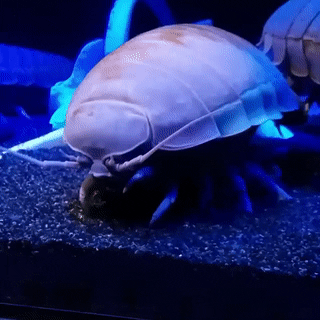
Giant Isopod
Bathynomus kensleyi
The Giant Isopod is an unsettling deep sea creature that crawls along the ocean floor scavenging for animal remains and detritus. These invertebrates are part of phenomenon known as abyssal gigantism, which is the tendency for deep-sea dwelling invertebrates to be larger than their shallower-water counter parts. The Giant Isopod is found between 310m to 2140m in the ocean.
Photo credit
https://seatrench.tumblr.com/post/615873390014791680/giant-isopod-bathynomus-sp-source
https://alchetron.com/Giant-isopod

Brittle Stars
Asteroschema Ajax
Brittle stars are in the phylum Enchinodermata and are closely related to sea stars. They have long stringy arms and small podia on the bottoms of their body. They also have a hydrostatic skeleton and have a complex water vascular system. When attacked, they will abandon their arm to confuse predators and make a hasty escape. The photo above is a deep sea brittle star that lives in coral reefs.
Photo credit: https://species.wikimedia.org/wiki/Asteroschema_ajax

Scaly Dragonfish
Stomias Boa
The Scaly Dragonfish is about 32cm long and found at depths between 200 to 1500m. The long purple barbel on its chin is used to lure in prey. When the pery gets close enough, it swings its jaws forward swallowing the prey whole.
Photo credit: https://alchetron.com/Stomias
Video on the fish: https://www.youtube.com/watch?time_continue=69&v=9oB_61aI2iQ&feature=emb_title

Squarenose Helmetfish
Scopelogadus beanii
The Squarenose Helmetfish is found between 800m to 4000m in the ocean. It received this unique name due to its scales reminding scientists of an armored helmet worn by medieval knights. It also has unusual holes around its face, and the white strands covering its face are sensory canals.
Photo credit: https://www.vistaalmar.es/especies-marinas/peces-extranos/449-que-peces-mas-extranos.html


Gulper Eel
Saccopharynx sp.
The Gulper Eel is known for its massive jaws, which are capable of swallowing prey whole. It’s stomach is also able to expand twice its size. It is found only in the deep see about 2000 to 3000 meters in depth.
Photo credit: https://www.youtube.com/watch?v=XRO0IjSoHGA
https://marinebiochemistrygc2018.weebly.com/deep-sea-adaptations
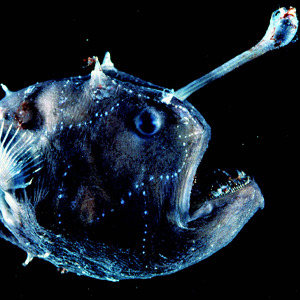

Football Fish
Himantolophus paucifilosus
The Football fish is a deep sea angular fish located between 1000 to 4000 meters in the ocean. The glowing dots on its body are sensory organs called neuromast that help the fish detect changes in the water.
Photo credit: https://alchetron.com/Footballfish
https://www.amazon.com/Creatures-Deep-Search-Monsters-World/dp/1770852816

Threadfin Snailfish
Careproctus longifilis
The Threadfin Snailfish resembles a prehistoric tadpole that is ghostly white. The holes in its face are large sensory pores that help them detect changes in the ocean. It is often found at depths between 1900 to 2997 meters.
Photo credit: https://www.timeout.com/singapore/museums/creatures-of-the-deep

Pram Bug
Phronima sedentaria
The Pram Bug is a deep sea amphipod that is located between 200 to 1000m in the ocean. It has a translucent exoskeleton and can see primarily blue light. It is also is contained in a hollowed out barrel that is used for protection and to house babies. The image above is a female pram bug carrying its young.
Photo Credit:https://ocean.si.edu/ocean-life/invertebrates/phronima-female-and-young

Marrus orthocanna
Marrus orthocanna is a deep sea siphonophore found at depths between 400m to 2200m. It has a colony of gas-filled zooids on the top used for locomotion. It also has a long, bright orange tentacles on the bottom. Marrus orthocanna are viscous predators and consume small crustceans and copepods.
Photo credit: http://www.arcodiv.org/watercolumn/cnidarian/Marrus_orthocanna.html

Hula Skirt Siphonophore
Physophora hydrostatica
The Hula Skirt Siphonophore a deep sea siphonophore that is found between 700 m to 1000m. It is made of a colony of hundreds tiny zooids. The top portion of the colony holds the swimming bells, which allow the colony to move. The bottom of the siphonophore holds the orange ‘hula skirt,’ which is full of stinging tentacles.
Photo link : https://twitter.com/montereyaq/status/1162068535331311617?lang=da
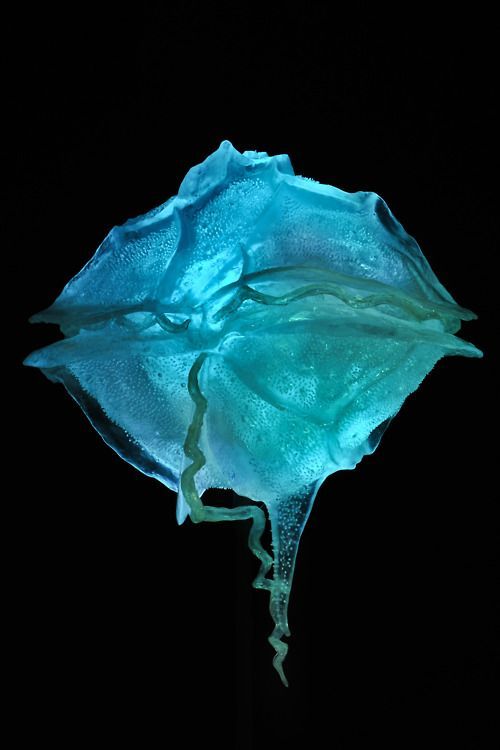

Pyrodinium bahamense
Pyrodinium bahamense is a tropical species of dinoflagellates that is found primarily in Atlantic Ocean waters. It prefers salinity around 20 psu and blooms when there are large amounts of nitrogen in the water. The dinoflagellate glows bright blue when agitated by motion. Furthermore, even though this plankton species is beautiful to look at, it causes seafood toxicity.
Photo credit: https://alchetron.com/Pyrodinium-bahamense
https://wonderchews.com/bodies-of-light/


Sea elephant
Carinaria japonica
The Sea Elephant is a translucent sea snail that has a large muscular body and a tiny triangular shell. Its foot is used for crawling on the ground, and it can be transformed into a fin that is used for swimming. It is called the “sea elephant” because it has a small trunk in its mouth that is used to swallow prey. Furthermore, the Sea Elephant eats arrow worms and jellies.
Photo credit
https://bodegahead.blogspot.com/2014/12/carinaria-part-2.html
http://tolweb.org/Carinaria_japonica/28750


Deep Sea Arrow Worm
Eukrohnia hamata
Arrow worms are small, predatory marine worms that consume copepods, ostracods, and larvae. They resembles a clear, ink pen whizzing through the dark sea. Furthermore, they are found primarily in the Artic Ocean between 700m to 1200m. The picture on the bottom is its head. They have 8 hooks, which are used to grab prey and 25 posterior teeth. Even though the arrow worms are terrifying up close, they are only 4.5 cm in size.
Photo credit: http://www.arcodiv.org/watercolumn/chaetognaths/Eukrohnia_hamata.html

Crystal Jellyfish
Aequorea victoria
The Crystal Jellyfish is a graceful, transparent jellyfish with long, thin tentacles. It has bioluminescent organs around it bell that produce a bright, green light. It tends to consume small copepods, but it has the ability to swallow other jellyfish half its size. Furthermore, this jelly is used in biological experiments to detect calcium.
Photo credit: https://www.montereybayaquarium.org/animals/animals-a-to-z/crystal-jelly
https://fineartamerica.com/featured/5-aequorea-crystal-jellyfish-with-amphipods-alexander-semenovscience-photo-library.html


Physonect Siphonophore
Nanomia cara
The Physonect siphonophore has tiny, bubble shaped sacs that are filled with gas. The sacs are called pneumatophores and help this creature move through the deep ocean. It also has venomous tentacles that stun prey and over eighty stomachs. There are numerous amounts of these strange creatures along the east coast, and they have cause some fisheries to collapse. Furthermore, they can be found at depth between 400m to 1000m.
Photo credit: http://www.seawater.no/fauna/cnidaria/cara.html
https://www.mindenpictures.com/stock-photo-siphonophore-hydrozoan-cnidarian-nanomia-cara-atlantic-nectophores-naturephotography-image90194961.html


Sea Gooseberry
Pleurobrachia pileus
The Sea Gooseberry is a comb jelly or ctenophore that has two enormous tentacles covered with adhesive cells. When tiny crustaceans, eggs, and larvae brush against the tentacles, the prey are stuck to them. The Sea Gooseberry draws the tentacles to its mouth, and it consumes the prey. These unique organisms can be found as deep as 750 m.



Black Dragonfish
Idiacanthus atlanticus
The Black Dragonfish are needle-like fish that migrate between 500m and 2000m in the deep ocean. Females are black with 6 stripes and lack a barbel, pelvic fins, and sharp teeth. Males, on the other hand, are dark brown and have a barbel, which is the light producing structure on its chin. Furthermore, it uses bioluminescence to detect prey instead of lure prey.
Photo credit: https://scitechdaily.com/scientists-learn-secrets-from-ultra-black-skin-that-allows-deep-sea-fish-to-lurk-unseen/
https://steemit.com/life/@munnashah/the-most-terrible-and-surprising-7-animals-of-the-sea
https://knowyourmeme.com/photos/995601-thalassophobia


Wolftrap Angler
Thaumatichthys binghami
The Wolftrap Angler is slightly different from many other species of anglers. It has its bioluminescent lure located inside of its mouth instead of connected to its body. Even though it is intimidating up close, it is only nine centimeters in size. It is found in the deep ocean at 2432m.
Photo credit
https://en.wikipedia.org/wiki/Thaumatichthys_binghami
https://igniteyourcuriosity.wordpress.com/2016/10/22/anglerfish/


Silky Medusa
Colobonema sericeum
The Silky Medusa is a gentle and reserved jellyfish; it has white-tipped tentacles that have the ability to detach from its body and bioluminescence when attacked by predators. It can be found drifting between 500 m to 1500 m. Furthermore, it consumes small crustaceans.
Photo credit: https://twitter.com/mbari_news/status/949736123760340994
https://www.montereybayaquarium.org/animals/animals-a-to-z/midwater-jelly


Cigar Comb Jelly
beroe forskalii
The Cigar Comb Jelly is a gelatinous ctenophore that is marveled by many due to its sparkling bioluminescence. It tends to elegantly float around 120 m in the ocean. It uses unique, hair-like structures called ctens to move horizontally in the ocean. It also swims in a spiral pattern before consuming zooplankton in the ocean.
Photo credit: https://www.wrobelphoto.com/gelatinouszooplankton/h25347306
https://www.flickr.com/photos/a_migotto/27227530815
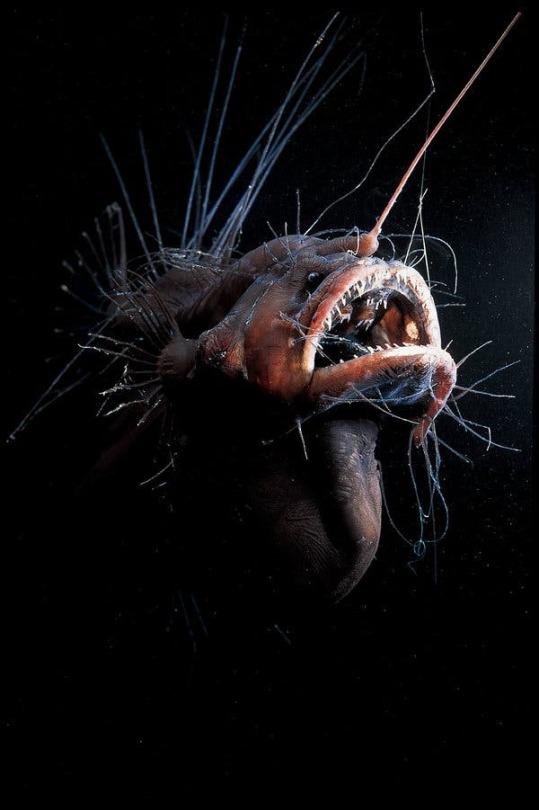
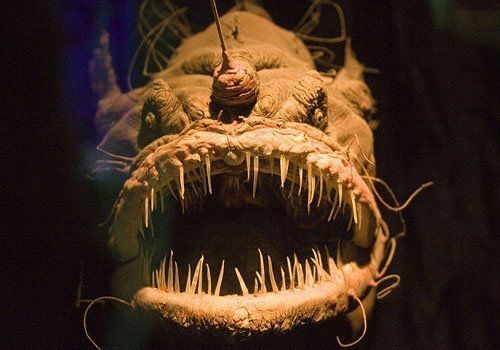
Fanfin Seadevil
Caulophyyne jordani
The Fanfin Seadevil is an ugly, deep fish that is covered in gnarled skin and long sensory filaments. The sensory filaments allow this species of anglerfish to detect movement in the water; this helps the Fanfin find and lure its prey. Furthermore, this deformed monstrosity can be found floating between 700m to 3000m in the ocean.
Photo credit: https://www.nytimes.com/2019/07/29/science/anglerfish-bioluminescence-deep-sea.html
http://www.robotspacebrain.com/alien-creatures-of-the-mariana-trench/


Lav Polyp
leuckartiara octona
The Lav Polypo is a jelly that comes in a variety of colors and shapes; it dwells about 200m in the deep ocean. The red mass inside its translucent bell is the jelly’s reproductive organs. Furthermore, it uses its dull, yellow tentacles can catch unsuspecting prey.
Photo credit: https://www.pinterest.com/pin/65935582019848580/
https://www.petjellyfish.co.uk/shop/live-jellyfish/leuckartiara-octona
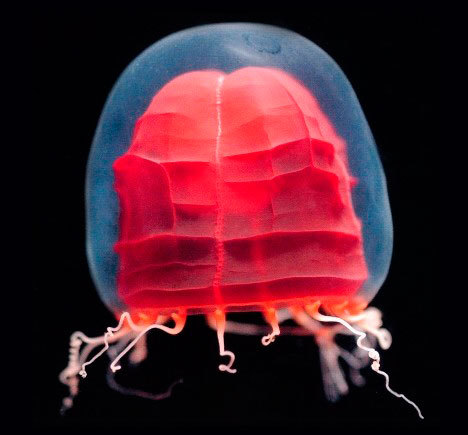

Red Paper Lantern Medusa
Pandea rubra
The Red Paper Lantern resembles a floating, Japanese paper lantern in the deep sea. It has the ability to crumple and wrinkle its bright, red bell, and it is located at depths between 550m to 1200m. It has also been nicknamed the “origami jelly.”
Photo credit: https://commons.wikimedia.org/wiki/Category:Pandea_rubra
http://www.thegorgeousdaily.com/pandea-rubra/
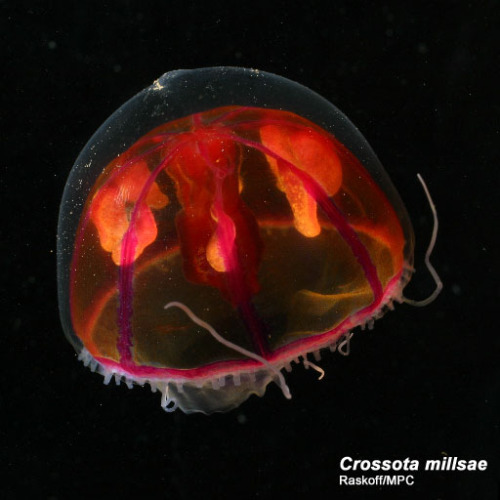
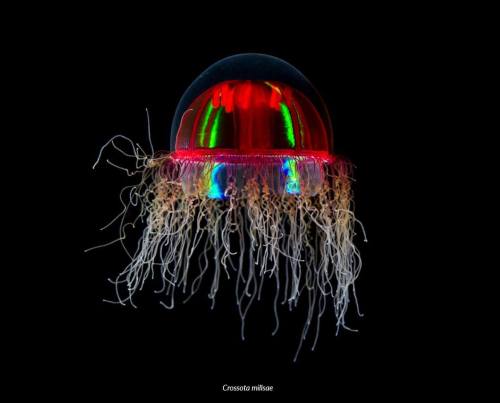
Psychedelic Medusa
Crossota millsae
The Psychedelic Medusa is a deep-sea hydrozoan that is abundant in the North Pacific. The mini-jelly is found at depths between 1000m to 3800m, and are often observed drifting near the ocean floor. It also has an eccentric reproduction behavior uncommon in cnidarians. The females display viviparity, and carry the babies in her bell until they are ready to hatch.
Photo credit: http://www.arcodiv.org/watercolumn/cnidarian/Crossota_millsae.html
https://twitter.com/spothvegr/status/1030177493075079169


Atolla Jelly
Atolla wyvillei
The Atolla Jelly is a fiery, red jellyfish that has an extraordinary display of bioluminescence. When the jelly is attacked, it uses bioluminescence to produce thousands of vibrant, blue flashes; the blue flashes act as an alarm, which draws in bigger predators and warns prey. The jelly can be found at depths between 600 m to 1500m, and it also has a long hypertrophied tentacle that aids in reproduction.
Photo credit: https://en.wikipedia.org/wiki/Atolla_jellyfish
https://en.wikipedia.org/wiki/Atolla_jellyfish

Black Medusa
Vampyrocrossota childressi
The Black Medusa is an inky, black hydrozoan that absorbs all light that hits its tiny body. It has a translucent gelatin and a black umbrella; it is also only 1.5 cm in size. Moreover, it is found at depths between 600m to 1500m, and it spends its entire life floating in the deep ocean.
Photo credit: https://www.pinterest.com/pin/488148047080475827/


Pigbutt worm
Chaetopterus pugaporcinus
The Pigbutt worm or the flying buttocks of the sea is spotted floating between 965 m to 1300 m in the deep ocean. It is actually a polychaete (polly-keet) worm species that burrows in the ground as an adult, and floats around the ocean as a baby. The worm feeds itself : by creating a balloon of mucus; collecting particles on the mucus; and then consuming the particles. It is the rarest and thickest worm in the deep ocean, for only ten have been spotted.
Photocredit: https://roaring.earth/pigbutt-worm/


Black-devil anglerfish
Melanoncetus johnsoni
The Black-devil anglerfish is a skilled predator that lurks in the darkness. It uses a bioluminescent organ, a top its head, to lure unsuspecting prey into its jaws. Even though these fish are terrifying to look at, they are about the size of a grape fruit. To save energy, they remain immobile in the water, yet they can detect even the slightest vibrations. Since finding a mate is hard at this depth, male fish will attach themselves to a female and slowly dissolve into her tissue; so she is able to use the sperm the male provides at any time. In addition, this is the fish that tried to eat Marlin and Dory in “Finding Nemo.”
Photo credit: https://underthevastblueseas.tumblr.com/post/40882487364/this-female-black-devil-anglerfish-with-her-flabby
https://www.pinterest.fr/pin/574631233709001328/